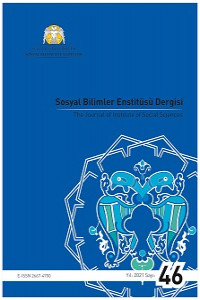Abstract
Cinsiyet eşitsizliği sorunu sosyal ve yasal normlarla izlenebilir. Eşit olmayan ekonomik şartlar, eğitime erişim ve ayrıca karar alma süreci olarak şekillenebilir. Roller cinsiyete göre farklılaştığında kadın ve erkeklerin kaynaklara nasıl erişebileceklerini belirlemektedir. Bunlar balıkçılık, su ve tarım gibi kaynaklar olabilir. Kanıtlar, GBVsta'nın bu tür bir güç dengesizliğinin sürdürülmesini sağlamak için her zaman kullanıldığını göstermiştir. Sosyokültürel beklentiler ve normlar ciddi bir şekilde güçlenmektedir. Bunlar yalnızca cinsiyet eşitsizliği sorununu daha da kötüleştirmekte başarılı olmaktadırlar. Bu makale Türkiye'deki cinsiyete dayalı şiddetin sınırlarını çizecektir. 1980'lerden beri bu durum devletin ve sivil toplum kuruluşlarının gündemine dahil edilmektedir. Cinsiyet politikası da odaklanılması gereken bir durumdur. Kadına yönelik şiddet konusu ciddiye alınması gereken bir konudur. Bunun nedeni, sadece bir suç eylemi olmaması, aynı zamanda bazı ekonomik ve sosyal sonuçları olabilmesidir. Bir toplum katı olduğu düşünülen toplumsal cinsiyet rollerini benimsemeye başladığında her zaman kadınlar ve erkekler arasında bariz eşitsizlik sorunu doğar. Türkiye'de aile içi şiddetin nasıl analiz edildiğini engelleyen önemli bir sorun veya zorluk vardır ve bu istatistiksel materyallerin bulunmamasıdır. Örneğin yetersiz malzeme nedeniyle ülke çapında anket yapılamamaktadır. Fakat biz sağlık kurumlarından, üniversitelerden ve kadın kuruluşlarından sınırlı veri toplamayı başardık. Böyle bir çabaya rağmen, verilerin yüzde yüz güvenilir olduğunun garantisi yoktur. Bunun nedeni, çoğu kadının utanç, güvende olmama korkusu ve eğitimsizlikten dolayı doğru bilgi verememesidir. Dünyadaki çoğu ülkede olduğu gibi, Türkiye'de de aile içi şiddet sorunu oldukça endişe verici hale gelmektedir.
Keywords
References
- Cudeville E. & Gurbuzer L. Y. (2007). Gender Wage Discrimination in the Turkish labor market. Documents de travail du Centre d'économie de la Sorbonne.
- Goldin, C. (1994). The U-shaped female labor force function in economic development and economic history. NBER working paper no. 4707.
- Greulich A., Dasre A. & Inan C. (2016b). Two or Three Children? Turkish Fertility at a Crossroads. Population and Development Review, September 2016
- MoNE (2017), Millî Eğitim İstatistikleri [National Education Statistics, Formal Education 2016/2017], Ministry of National Education, Ankara http://sgb.meb.gov.tr/meb_iys_dosyalar/2017_03/31152628_meb_istatistikleri_orgun_egitim_2016_2017_1.pdf. [Accessed: 21 February 2021].
- MoNE (2018). Outlook of vocational and technical education in Turkey, https://mtegm.meb.gov.tr/meb_iys_dosyalar/2018_11/12134429_No1_Turkiyede_Mesleki_ve_Teknik_Egitimin_Gorunumu.pdf. [Accessed: 21 February 2021].
- Tozlu, Ç. and Göksel, A. (2016). WAVE: Violence against Women Country Report Turkey, Turkish Social Sciences Association. https://notus-asr.org/wp-content/uploads/2016/05/WAVE_Report_Turkey_FINAL_EN_6March2016-3-3.pdf [Accessed: 18 February 2021].
- Turkstat Labour Force Surveys (2019). Retrieved from https://www.tuik.gov.tr/Home/Index [Accessed: 24 February 2021].
- UNFPA (2015). Combatting Violence Against Women and Girls in Eastern Europe and Central Asia. Issue brief 6, 2015.
- Word Bank (2009). World Development Report – Gender Equality and Development, World Bank Publishing, Washington D.C.
- World Development Indicators (2015). https://databank.worldbank.org/source/world-development-indicators [Accessed: 25 February 2021].
- World Bank (2020). Fertility rate. https://data.worldbank.org/indicator/SP.DYN.TFRT.IN [Accessed: 25 February 2021].
Abstract
Gender inequality can be traced back to social and legal conventions. It could manifest itself in the form of unequal economic opportunity, educational access, and decision-making processes. When roles are divided based on gender, men and women will have different access to resources within them. Fisheries, water, and agriculture are examples of such resources. GBV has always been used or employed to preserve such a power imbalance, according to evidence. Expectations and conventions in society have been ruthlessly enforced. These have only served to exacerbate the issue of gender inequality. The focus of this study will be on gender-based violence in Turkey. Since the 1980s, this has been included in the state’s agenda and that of civil society organizations. There is also need for gender politics to be focused on. Violence against women is an issue that needs to be taken seriously. This is because it is not just a criminal act but can also have some economic and social implications. When a culture adopts gender norms that are considered inflexible, there is always the issue of visible imbalance between men and women. There is a significant issue or challenge that has hampered the analysis of domestic violence in Turkey. This study takes a critical look at the topic in this regard. In addition to the neglect of this problem in Turkey, women have been left behind in education, employment, the language of violence against women in the media, the insufficient law is both effective and worrying in the domestic violence problem in Turkey.
Keywords
References
- Cudeville E. & Gurbuzer L. Y. (2007). Gender Wage Discrimination in the Turkish labor market. Documents de travail du Centre d'économie de la Sorbonne.
- Goldin, C. (1994). The U-shaped female labor force function in economic development and economic history. NBER working paper no. 4707.
- Greulich A., Dasre A. & Inan C. (2016b). Two or Three Children? Turkish Fertility at a Crossroads. Population and Development Review, September 2016
- MoNE (2017), Millî Eğitim İstatistikleri [National Education Statistics, Formal Education 2016/2017], Ministry of National Education, Ankara http://sgb.meb.gov.tr/meb_iys_dosyalar/2017_03/31152628_meb_istatistikleri_orgun_egitim_2016_2017_1.pdf. [Accessed: 21 February 2021].
- MoNE (2018). Outlook of vocational and technical education in Turkey, https://mtegm.meb.gov.tr/meb_iys_dosyalar/2018_11/12134429_No1_Turkiyede_Mesleki_ve_Teknik_Egitimin_Gorunumu.pdf. [Accessed: 21 February 2021].
- Tozlu, Ç. and Göksel, A. (2016). WAVE: Violence against Women Country Report Turkey, Turkish Social Sciences Association. https://notus-asr.org/wp-content/uploads/2016/05/WAVE_Report_Turkey_FINAL_EN_6March2016-3-3.pdf [Accessed: 18 February 2021].
- Turkstat Labour Force Surveys (2019). Retrieved from https://www.tuik.gov.tr/Home/Index [Accessed: 24 February 2021].
- UNFPA (2015). Combatting Violence Against Women and Girls in Eastern Europe and Central Asia. Issue brief 6, 2015.
- Word Bank (2009). World Development Report – Gender Equality and Development, World Bank Publishing, Washington D.C.
- World Development Indicators (2015). https://databank.worldbank.org/source/world-development-indicators [Accessed: 25 February 2021].
- World Bank (2020). Fertility rate. https://data.worldbank.org/indicator/SP.DYN.TFRT.IN [Accessed: 25 February 2021].
Details
| Primary Language | English |
|---|---|
| Journal Section | Research Articles |
| Authors | |
| Publication Date | October 20, 2021 |
| Submission Date | April 5, 2021 |
| Published in Issue | Year 2021 Issue: 46 |
This work is licensed under a Creative Commons Attribution-NonCommercial 4.0 International License

